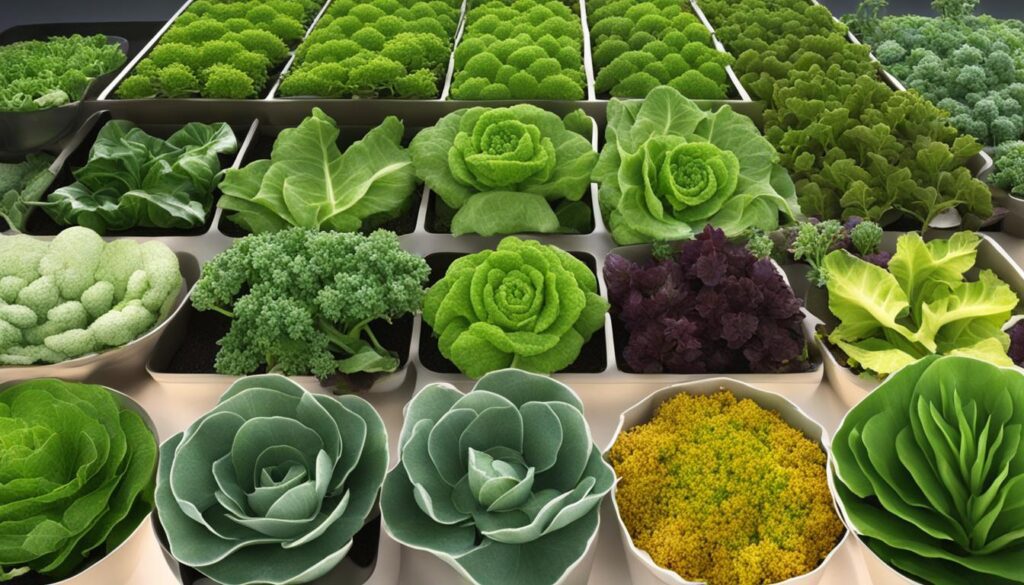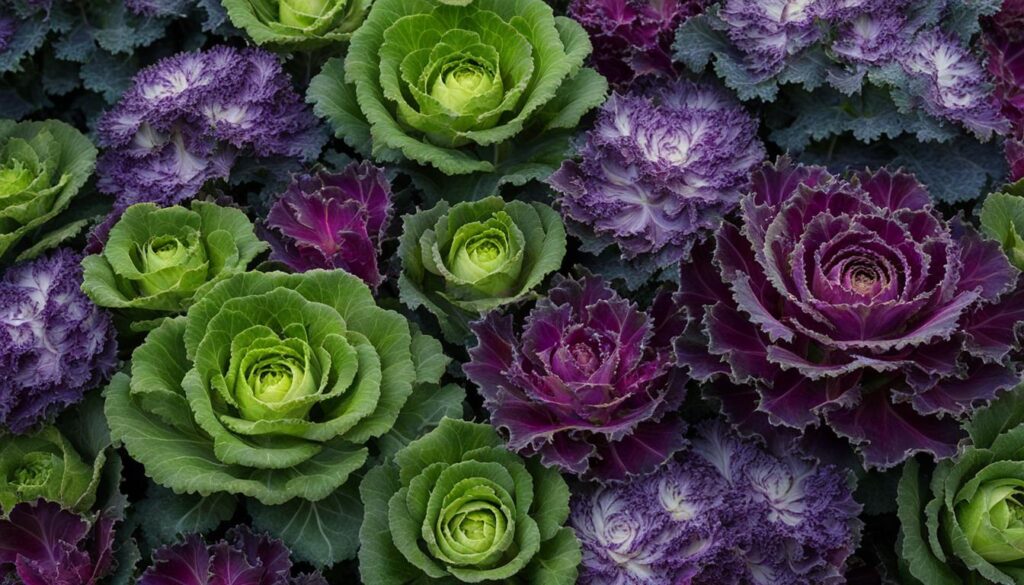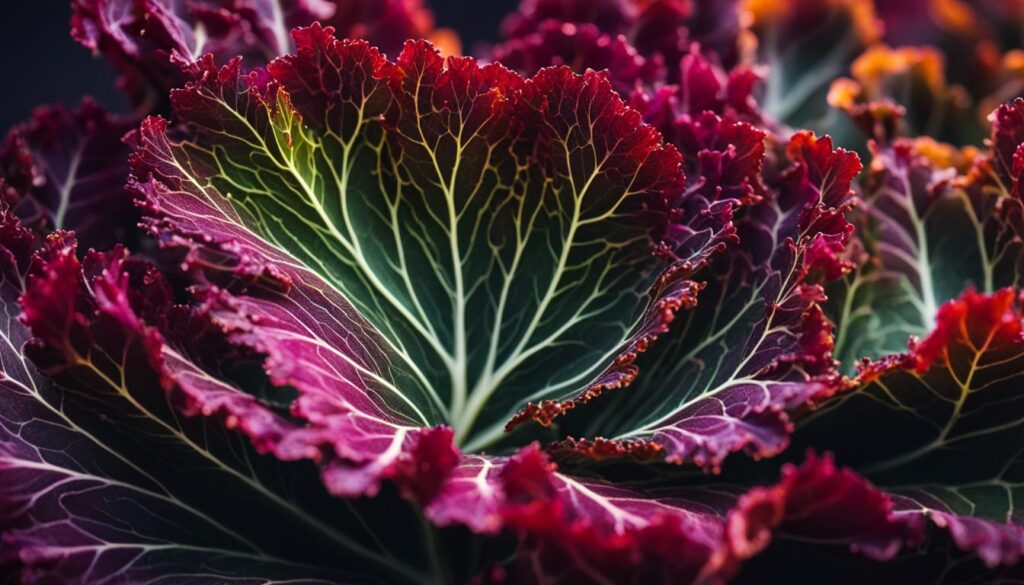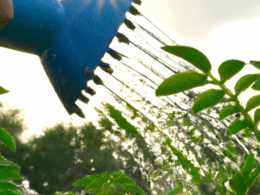Brassica plants, such as kale and cabbage, are commonly found in gardens and floral designs. But do these plants actually produce flowers? Let’s dive into the fascinating world of Brassica plants and explore their unique characteristics.
Post Summary
- Brassica plants, like kale and cabbage, do not produce traditional flowers.
- Instead of flowers, these plants form rosette-like shapes with their central leaves.
- Ornamental kale and cabbage are bred for their vibrant foliage colors and are primarily grown for decoration.
- Weather conditions and exposure to cooler temperatures play a significant role in the coloration of leaves.
- Popular cultivar series include ‘Chidori’ ornamental kale, ‘Color Up’ ornamental cabbage, ‘Osaka’ ornamental cabbage, and ‘Peacock’ compact hybrids.
Now that we know Brassica plants don’t produce traditional flowers, we can appreciate their unique beauty and incorporate them into our gardens and floral designs. Let’s explore further to understand their origins, characteristics, and care tips for these fascinating plants.
The Origins of Brassica Plants
Brassica oleracea plants, the species to which kale and cabbage belong, have ancient origins that date back at least 4,000 years. They were originally cultivated in the Mediterranean region by the Greeks and Romans as a food source and for medicinal purposes. Over time, these plants were spread to other parts of the world by travelers and traders.
The Origins of Brassica Plants
| Ancient Origins | Mediterranean Region |
|---|---|
| The Brassica oleracea species | The Greeks and Romans cultivated kale and cabbage |
| Dated back at least 4,000 years | Used as a food source and for medicinal purposes |
| Spread to other parts of the world by travelers and traders |
Brassica oleracea plants, such as kale and cabbage, have their ancient origins in the Mediterranean region. The Greeks and Romans were the first to cultivate these plants around 4,000 years ago. They valued kale and cabbage not only as a source of food but also for their medicinal properties. As travelers and traders interacted with these ancient civilizations, they brought the Brassica oleracea plants to different corners of the world, contributing to their global spread.
The Mediterranean region provided ideal conditions for the cultivation of Brassica oleracea plants. These plants thrived in the mild climate and fertile soils, allowing them to flourish and become staples in ancient diets. The Greeks and Romans recognized their nutritional value and incorporated kale and cabbage into their cuisine. Additionally, they discovered the medicinal benefits of these plants, utilizing them to treat various ailments.
Over time, Brassica oleracea plants became revered and sought after in other parts of the world. As travelers and traders ventured beyond the Mediterranean region, they introduced kale and cabbage to new environments. This expansion contributed to the global popularity and widespread cultivation of Brassica oleracea plants, which continue to be cherished for their diverse culinary uses and ornamental value today.
Characteristics of Ornamental Kale and Cabbage
Ornamental kale and cabbage plants offer a stunning display of foliage color, adding visual interest to gardens and floral designs. These hybrids of edible kale types have been specifically bred for their vibrant leaves, making them popular choices for those seeking unique and eye-catching plants.
The foliage of ornamental kale and cabbage comes in a wide range of colors, including cream, green, pink, purple, blue, red, and white. The leaves are often frilly or ruffled, adding volume and texture to the plants. This diversity in leaf color and shape allows for creative and striking combinations when incorporating them into floral arrangements or garden beds.
Not only are ornamental kale and cabbage visually appealing, but they also offer versatility in terms of their use. Whether used as standalone plants, mixed with other ornamental varieties, or as cut flowers, these plants provide a vibrant and unique element to any setting.
| Characteristics | Ornamental Kale | Ornamental Cabbage |
|---|---|---|
| Leaf Shape | Deeply serrated or ruffled | Broad and rounded |
| Leaf Color | Varies, including purple, white, or magenta | Varies, including green outer leaves with white or deep pink cores |
| Leaf Growth | Grows in tight rosettes | Grows in heads similar to cabbage |
| Cultivar Examples | ‘Chidori’ | ‘Color Up’ |
With their captivating foliage colors and unique leaf structures, ornamental kale and cabbage plants are a fantastic addition to any garden or floral design. Whether you’re seeking a pop of color or a distinctive texture, these plants are sure to provide the visual interest you desire.
Differences Between Ornamental Kale and Ornamental Cabbage
When it comes to ornamental kale and cabbage, there are distinct differences in leaf shape and structure that set them apart. Ornamental kale plants have deeply serrated or ruffled leaves, creating a feathery and textured appearance. On the other hand, ornamental cabbage plants have broad, smooth, and rounded leaves that resemble the traditional cabbage we eat. These variations in leaf shape contribute to the unique visual appeal of each plant.
To further differentiate the two, ornamental kale leaves grow in tight rosettes, forming a compact and layered look. This growth pattern makes them ideal for adding depth and dimension to floral designs or garden beds. In contrast, ornamental cabbage leaves grow in heads, similar to the cabbage found in the kitchen. The round heads provide a bold and striking focal point, making them popular choices for standalone displays.
Within the realm of ornamental kale, there are different cultivars to explore. Fringed-leaved cultivars feature finely ruffled leaf margins, adding an elegant and delicate touch to arrangements. Feather-leaved cultivars, on the other hand, have finely serrated and deeply notched leaves, creating a more intricate and textured appearance. These unique leaf structures open up endless possibilities for creative and visually captivating displays.
| Ornamental Kale | Ornamental Cabbage |
|---|---|
| Serrated or ruffled leaves | Broad, smooth, and rounded leaves |
| Grows in tight rosettes | Grows in heads |
| Fringed-leaved cultivars available | No fringed-leaved cultivars |
| Feather-leaved cultivars available | No feather-leaved cultivars |
“The variations in leaf shape and structure between ornamental kale and cabbage allow for endless creativity in floral designs and garden displays.”
Factors Affecting Leaf Coloration in Ornamental Kale and Cabbage
The intense coloration of the leaves in ornamental kale and cabbage is influenced by weather conditions, particularly temperatures below 60°F (15°C) for an extended period. During this time, the color development process takes place, resulting in the vibrant hues that make these plants so visually striking. The exposure to cooler temperatures suppresses chlorophyll production, allowing the underlying tones of white, pink, blue-green, purple, and bi-color combinations to emerge and intensify.
It is crucial to note that frosty weather plays a significant role in the leaf coloration process. Frost suppresses chlorophyll production further, facilitating the development of the desired colors. This unique characteristic sets ornamental kale and cabbage apart from their edible counterparts, as they are grown primarily for their decorative foliage rather than for consumption.
“The exposure to cooler temperatures for at least two to four weeks is essential for the leaves to develop their vibrant colors,” explains Dr. Botanist, a plant expert. “The underlying pigments become more prominent when chlorophyll production is suppressed, resulting in the stunning hues seen in ornamental kale and cabbage.”
The leaf coloration of these plants is a fascinating natural process that adds a touch of beauty to gardens, flower arrangements, and landscapes. By understanding the impact of weather conditions and frost on chlorophyll production, you can enhance the visual appeal of your ornamental kale and cabbage plants to create stunning displays.
Factors Affecting Leaf Coloration in Ornamental Kale and Cabbage
| Factor | Description |
|---|---|
| Temperature | Exposure to temperatures below 60°F (15°C) for at least two to four weeks is necessary for color development. |
| Frost | Frosty weather further suppresses chlorophyll production, allowing vibrant colors to emerge |
| Chlorophyll Production | Chlorophyll production is limited in cooler temperatures, revealing the underlying pigments. |
Growing and Care Tips for Ornamental Kale and Cabbage
Proper plant selection is essential when choosing ornamental kale and cabbage for your garden or floral designs. Look for plants with straight, sturdy stems and compact heads that display vibrant colors. Avoid plants with damaged or yellowing leaves as they may indicate poor health or inadequate care.
To maintain the vibrant colors of ornamental kale and cabbage, it is important to provide the right care. Keep them in areas where temperatures below 60°F (15°C) can be maintained for three to four weeks. This will encourage color formation and intensification in the leaves. Additionally, changing the container’s water every two to three days helps minimize odors and keeps the plants hydrated.
Regular care and maintenance are crucial for the longevity of ornamental kale and cabbage. Remove any yellowing leaves promptly to prevent the spread of diseases or pests. When using these plants as cut flowers, recut the stems under running water and hydrate them in a biocide solution for at least two hours before storage or use. Following these care tips will help ensure the health and beauty of your ornamental kale and cabbage plants.
Care Tips for Ornamental Kale and Cabbage
| Care Tips | Description |
|---|---|
| Select robust plants | Choose ornamental kale and cabbage plants with straight, sturdy stems and compact heads displaying vibrant colors. |
| Maintain cool temperatures | Keep the plants in areas where temperatures below 60°F (15°C) can be maintained for three to four weeks to encourage color formation and intensification. |
| Change water regularly | Change the container’s water every two to three days to minimize odors and keep the plants hydrated. |
| Remove yellowing leaves | Promptly remove any yellowing leaves to prevent the spread of diseases or pests. |
| Proper stem care | When using ornamental kale and cabbage as cut flowers, recut the stems under running water and hydrate them in a biocide solution for at least two hours before storage or use. |
By following these growing and care tips, you can enjoy the vibrant colors and visual interest that ornamental kale and cabbage plants bring to your garden or floral designs. Whether you are a seasoned gardener or a beginner, these unique plants are sure to add beauty and intrigue to any space.
Conclusion
Although Brassica plants like kale and cabbage do not produce traditional flowers, their unique central leaves that form rosette-like shapes give them the appearance of flowering. These ornamental kale and cabbage plants are grown primarily for their decorative foliage, which comes in a variety of colors and offers strong visual interest.
Understanding the characteristics and care tips for these plants can help you effectively incorporate them into your garden or floral designs. When selecting ornamental kale and cabbage plants, look for those with straight, sturdy stems and compact heads showing bright colors. Avoid plants with damaged or yellowing leaves.
To maintain the vibrant colors of these plants, keep them in areas where temperatures below 60°F (15°C) can be maintained for three to four weeks. Change the container’s water every two to three days and remove any yellowing leaves to minimize odors. When using them as cut flowers, recut the stems under running water and hydrate them in a biocide solution for at least two hours before storage or use.
By following these care tips and making thoughtful selections, you can enhance your garden or floral arrangements with the beauty of ornamental kale and cabbage. Their captivating foliage and unique appearance will surely make a statement and add a touch of elegance to any setting.
FAQ
Do Brassica plants produce traditional flowers?
No, Brassica plants, such as kale and cabbage, do not produce traditional flowers. Instead, the central leaves of the plant form rosette-like shapes that are often mistaken for flowers.
What is the origin of Brassica plants?
Brassica plants, belonging to the Brassica oleracea species, have ancient origins that date back at least 4,000 years. They were originally cultivated in the Mediterranean region by the Greeks and Romans as a food source and for medicinal purposes.
What is the purpose of growing ornamental kale and cabbage?
Ornamental kale and cabbage plants are primarily grown for their decorative foliage rather than for their taste. The leaves of these plants come in a variety of colors and offer strong visual interest, making them popular choices for floral designs and home gardens.
What are the differences between ornamental kale and ornamental cabbage?
Ornamental kale plants have deeply serrated or ruffled leaves, while ornamental cabbage plants have broad, smooth, and rounded leaves. The kale leaves grow in tight rosettes, while the cabbage leaves grow in heads similar to the cabbage we eat. There are also different types of ornamental kale, including fringed-leaved cultivars with finely ruffled leaf margins, and feather-leaved cultivars with finely serrated and deeply notched leaves.
How does leaf coloration develop in ornamental kale and cabbage?
The intense coloration of the leaves in ornamental kale and cabbage is determined by weather conditions. When exposed to temperatures below 60°F (15°C) for up to four weeks, the leaves’ colors form and intensify. Frosty weather suppresses chlorophyll production, allowing the underlying tones of white, pink, blue-green, purple, and bi-color combinations to develop.
What are some popular cultivar series of ornamental kale and cabbage?
There are several popular cultivar series of ornamental kale and cabbage available in the market. These include the ‘Chidori’ ornamental kale with curly leaf edges and purple, white, or magenta leaves, the ‘Color Up’ ornamental cabbage with green outer leaves and white or deep pink cores, the ‘Osaka’ ornamental cabbage with smooth leaves and a center of white, pink, or red, and the ‘Peacock’ compact hybrids with deeply serrated leaves in white, red, or purple.
How should I take care of ornamental kale and cabbage plants?
When selecting ornamental kale and cabbage plants, look for those with straight, sturdy stems and compact heads showing bright colors. To maintain the plants’ vibrant colors, keep them in areas where temperatures below 60°F (15°C) can be maintained for three to four weeks. Change the container’s water every two to three days and remove any yellowing leaves to minimize odors. When using them as cut flowers, recut the stems under running water and hydrate them in a biocide solution for at least two hours before storage or use.
Do Brassica Plants Also Have Perennial Varieties?
Hydrangeas perennial varieties are well-known for their ability to bloom year after year. However, when it comes to Brassica plants, the situation is quite different. Brassicas are primarily cultivated as annuals, meaning they complete their life cycle within a single year. While some may survive in milder climates, Brassica plants are generally not considered perennial.












